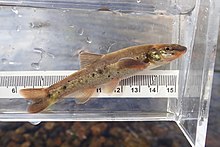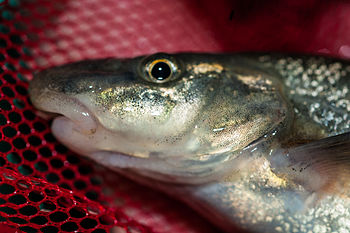| Longnose Dace | |
|---|---|

| |
| Conservation status | |
 Least Concern (IUCN 3.1) | |
| Scientific classification | |
| Domain: | Eukaryota |
| Kingdom: | Animalia |
| Phylum: | Chordata |
| Class: | Actinopterygii |
| Order: | Cypriniformes |
| Family: | Cyprinidae |
| Subfamily: | Leuciscinae |
| Clade: | Pogonichthyinae |
| Genus: | Rhinichthys |
| Species: | R. cataractae |
| Binomial name | |
| Rhinichthys cataractae (Valenciennes, 1842) | |
| Subspecies | |
| |
| Synonyms | |
| |

The longnose dace (Rhinichthys cataractae) is a freshwater minnow native to North America. Rhinicthys means snout fish (reference to the long snout) and cataractae means of the cataract (first taken from Niagara Falls). Longnose dace are small, typically less than 100 mm and characterized by their fleshy snout that protrudes past the mouth. They are well adapted for living on the bottom of fast-flowing streams among stones. Longnose dace eat algae and aquatic insects and are important forage minnows for larger predatory fish.
Description
Longnose dace can be mistaken for suckers because of their subterminal "sucker-like" mouth. However, longnose dace (like all members of the family Cyprinidae) lack small fleshy projections, called papillae, on their mouths.
Juveniles have a black lateral line that extends from the beginning of the eye to the caudal fin that fades as the fish matures. The lateral line in juveniles is not present in all populations. In adults, the dorsal side is dark green to black, the lateral side is darkish to silvery with mottling often present, and the ventral side is pearly. Both adult males and females may have bright orange-reddish colouration at the base of pectoral, pelvic, and anal fins and on the upper lip. This colouration is typically associated with breeding males in the subspecies Rhinichthys cataractae cataractae, but the validity of this subspecies has yet to be confirmed. Museum specimens of females also show intense orange-reddish colouration at the base of the fins and upper lip, therefore colouration is not an accurate predictor of sex.
The maximum length of longnose dace is 170 mm (6.7 in), but they are usually less than 100 mm (3.9 in).
Geographic distribution
Longnose dace have the widest distribution of any cyprinid in North America, with a range reaching as far south as the Rocky Mountains in northern New Mexico and as far north as the Mackenzie River near the Arctic Circle and across the continent from the Pacific to Atlantic coast. Multiple refugia during the most recent glacial maximum may explain the broad geographic distribution of longnose dace. There were up to three possible glacial refuges during Pleistocene glaciations: the Pacific, the Mississippi and the Atlantic. Longnose dace on the Quebec peninsula likely originated only from the Atlantic refuge, in contrast to other fish species on the peninsula that originated from multiple refugia. Longnose dace in northwestern North America originated from a Pacific refuge.
Ecology

Longnose dace occur in moderately cool water streams, rivers and lakes with temperatures up to 22 °C (72 °F). Longnose dace are benthic and preferentially occupy rock and gravel substrate. During the day longnose dace hide under rocks. Longnose dace prefer shallow, fast-moving riffles in streams and rivers and the turbulent, near-shore region of lakes.

Longnose dace are opportunistic foragers. Small longnose dace (≤ 50 mm (2.0 in)) primarily consume algae and benthic invertebrates dace (> 50 mm (2.0 in)) feed on fish scales, fish eggs, terrestrial insects, and aquatic benthic macroinvertebrates, although diet varies seasonally. They are nocturnal feeders, possibly to avoid predation and/or salmonid competitors.
Longnose dace have small home ranges and high site fidelity, however there is evidence that a small proportion are able to disperse distances greater than 500 km (310 mi).
Life history
Longnose dace reach reproductive maturity at age two and have a mean lifespan of three years. Males and females have a maximum age of four and five, respectively.

Longnose dace typically spawn from May to August in water 14 to 19 °C (57 to 66 °F) and some populations are multiple spawners. Time of spawning is dependent on water temperature. Longnose dace are polygynandrous and males create and defend territories to attract females to enter and spawn. Males form a depression in the rocky substrate and vibrate to attract a female. When a female is receptive, she enters the territory and pushes her snout into substrate in a similar manner as the male. Both male and female tremble over the depression and release eggs and milt. Limited or no parental care is provided to young-of-the-year after hatching.
Anthropogenic disturbance
In southern Alberta longnose dace are exposed to organic, estrogen-like compounds. Downstream of wastewater effluent from the city of Red Deer longnose dace are larger, increase in abundance, and have larger livers but males have reduced ability to produce testosterone. Despite a morphologically healthy appearance, longnose dace in the Red Deer River are physiologically stressed. In the Oldman River, some longnose dace populations are characterized by elevated vitellogenin expression, female biased sex ratios and intersex gonads. Feminization is likely caused by estrogen-like compounds present in municipal wastewater effluent, agriculture, and cattle operations near the Oldman River, however this mechanism is not well understood. It is not known if increased vitellogenin expression and intersex gonads significantly decrease reproductive success and will impact the long term viability of longnose dace in these systems. There is not evidence of skewed sex ratios in the Bow River.
References
- NatureServe.; Lyons, T.J. (2019). "Rhinichthys cataractae". IUCN Red List of Threatened Species. 2019: e.T62204A130050777. doi:10.2305/IUCN.UK.2019-2.RLTS.T62204A130050777.en. Retrieved 19 November 2021.
- ^ Bartnik, V.G. 1971. "Comparison of the breeding habits of two subspecies of longnose dace, Rhinichthys cataractae". Canadian Journal of Zoology 50: 83–86.
- ^ Nelson, J.S. and M.J. Paetz. 1992. The Fishes of Alberta. The University of Alberta Press. Edmonton, Alberta.
- ^ McPhail, J.D. and C.C. Lindsay. 1970. Freshwater Fishes of Northwestern Canada and Alaska. Freshwater Research Board of Canada. Ottawa, Ontario.
- Girand, A. and B. Angers. "The impact of postglacial marine invasions on the genetic diversity of an obligate freshwater fish, the longnose dace (Rhinichthys cataractae), on the Quebec peninsula". Canadian Journal of Fisheries and Aquatic Sciences 63: 1429–1438.
- McPhail, J.D. and E.B. Taylor. "Phylogeography of the longnose dace (Rhinichthys cataractae) species group in northwestern North America – the origin and evolution of the Umpqua and Millicoma dace". Canadian Journal of Zoology 87: 491–497.
- Edwards, E.A., H. Li and C.B. Schreck. 1983. "Habitat suitability index models: Longnose dace." U.S. Department of the Interior, Fish and Wildlife Service. FWS/OBS-82/10.33 13 pp.
- ^ Brazo, D.C., C.R. Liston and R.C. Anderson. 1978. "Life history of the Longnose dace, Rhinichthys cataractae, in the surge zone of the eastern Lake Michigan near Ludington, Michigan". Transactions of the American Fisheries Society 107(4): 550–556.
- Thompson, A.R., J.T. Petty and G.D. Grossman. 2001. "Multi-scale effect of resource patchiness on foraging behavior and habitat use by longnose dace, Rhinichthys cataractae". Freshwater Biology 46: 145–160.
- Culp, J.C. 1978. "Nocturnally constrained foraging of a lotic minnow (Rhinichthys cataractae)". Canadian Journal of Zoology 67: 2008-2012.
- Hill, J. and G.D. Grossman. 1987. "Home range estimates for three North American stream fishes". Copeia 1987(2): 376–380.
- Larson, G.L., R.L. Hoffman, and S.E. Moore. 2002. "Observations of the distribution of five fish species in a small Appalachian stream". Transactions of the American Fisheries Society 131(4): 791–796.
- Roberts, J.H. and G.D. Grossman. 2001. "Reproductive characteristics of female longnose dace in the Coweeta Creek drainage, North Carolina, USA". Ecology of Freshwater Fish 10: 184–190
- Jeffries, K.M., L.J. Jackson, M.G. Ikonomou, and H.R. Habibi. 2010. "Presence of natural and anthropogenic organic contaminants and potential fish health impacts along two river gradients in Alberta, Canada." Environmental Toxicology and Chemistry 29(10): 2379-2010.
- Jeffries, K.M., L.J. Jackson, L.E. Peters and K.R. Munkittrick. 2008. "Changes in population, growth, and physiological indices of longnose dace (Rhinichthys cataractae) in the Red Deer River, Alberta, Canada." Archives of Environmental Contaminants and Toxicology 55: 639–65.
- ^ Jeffries, K.M., E.R. Nelson, L.J. Jackson and H.R. Habibi. "Basin-wide impacts of compounds with estrogen-like activity on longnose dace (Rhinichthys cataractae) in two prairie rivers of Alberta, Canada." Environmental Toxicology and Chemistry 27(10): 2042–2052.
- Evans, J.S., L.J. Jackson, H.R. Habibi, and M.G. Ikonomou. 2012. "Feminization of longnose dace (Rhinichthys cataractae) in the Oldman River, Alberta, (Canada) provides evidence of widespread endocrine disruption in an agricultural basin." Scientifica 11 pages.
| Taxon identifiers | |
|---|---|
| Rhinichthys cataractae |
|